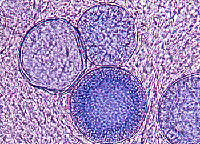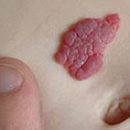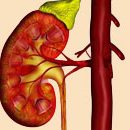What is mycosis? How coccidioidosis is manifested, histoplasmosis, blastomycosis, cryptococcosis? Read in this article.
Content
Mycoses
Mycoses are diseases caused by fungi infecting humans, animals and plants. Mycosis develops slowly, recurrences (resuming the manifestations of the disease after their temporary disappearance) more often than bacterial infection, and does not leave after a long-term immunity (body immunity). Sometimes fungal infections are accompanied by only small inflammation, but often cause the formation of chronic ulns, ulcers or tumor-like granuloma (inflammatory dense nodules). Mycoses may even cause death. There are means that slow down the reproduction of fungi, but there are no such that would completely destroy them.
There are a systemic micaosis that extends to the whole organism, and the dermatomycosis, in which the skin, hair or nails are affected.
Cocidioidosis
 Cocidioidosis (Cocidioidomycosis, or California Fever) caused by a filamentous yeast fungus Coccidioides Immitis. Most common in southern California, but meets throughout the southwest US. Transmission of infection from person does not happen. The fungus enters the body mainly when inhaling dust containing its disputes, but can penetrate and through the skin when contacting infected soil. Wild rodents are considered carriers of infection (for example, rats). Cocidioidosis – acute respiratory disease, which, as a rule, is cured spontaneously (without special treatment); However, sometimes the disease acquires a quick-spreading form that can lead to death.
Cocidioidosis (Cocidioidomycosis, or California Fever) caused by a filamentous yeast fungus Coccidioides Immitis. Most common in southern California, but meets throughout the southwest US. Transmission of infection from person does not happen. The fungus enters the body mainly when inhaling dust containing its disputes, but can penetrate and through the skin when contacting infected soil. Wild rodents are considered carriers of infection (for example, rats). Cocidioidosis – acute respiratory disease, which, as a rule, is cured spontaneously (without special treatment); However, sometimes the disease acquires a quick-spreading form that can lead to death.
Initially, cocidioidosis proceeds asymptomatic or resembles flu. Increases temperature, cough and chest pain with subsequent skin rashes. If the infection has fallen into the body through the skin, then small skin naps are formed at the site of its penetration. In most cases, these manifestations disappear without any treatment. Sometimes infection penetrates deep tissues: bones, joints, brain and brain shells, where inflammatory dense nodules are formed), later turning into abscesses (ulces) or ulcers. At the same time, the body temperature increases, the appetite is reduced, fast weight loss and forces occur. Effective treatments for this form of the disease. The spread of infection somewhat delays amphotericin drug.
Histoplasmosis
Histoplasmosis is caused by a yeast-like Histoplasma Capsulatum fungus, which multiplies in the litter of pigeons, bats and chickens. Meets all over the world in the USA – Main in the valleys of the Mississippi and Ohio. Infection occurs when inhaled dust containing infected litter, eating contaminated food or through the skin. In the body of the fungus settles in some tissues and blood cells. With the damage to the mouth, the pharynx or ears, the formation of an ulcer and an increase in nearby lymph nodes. The disease ends spontaneously, the chances of recovery are very high.
With the progressive form of histoplasmosis, the fungus penetrates into the internal organs, as a result of which the liver and spleen increase, and ulcers are formed in the intestines. Often infection extends to the bone marrow; In this case, at times the temperature increases, the person is losing weight, the content of erythrocytes and leukocytes fall in the blood. The progressive form of the disease often leads to fast death. Amphotericin slows down the spread of infection.
Blastomycosis
 Blastomicosis (North American Blastomycosis, or Gilcrist Disease) causes a yeast-like fungus Blastomyces dermatitidis. This is a rather rare disease that is chronic, can flow in the form of primary changes, limited skin or lungs, or gradually hit the whole organism. Natural tank of fungus-pathogen and how to transfer it is unknown. First on the face, the neck or limbs appear small reddish nodules or guns. Increasing in size, they are covered with a crust with small holes around the edges; Later some turn into ulcers. Damage at pulmonary blastomycosis resemble tuberculosis or lung cancer. The fungus can penetrate the bones, liver, spleen, kidney and the central nervous system, leading to the appearance of tumor-like formations there, which later turn into ulcers or abscesses. Pathological changes in the central nervous system can cause paralysis. During the spread of infection from bones or internal organs into the lungs in them, extensive changes are often arising, leading to death. Skin blastomycosis is amenable to radiation therapy and treatment of potassium iodide. Although most cases of blastomicosis are successfully treated with antifungal antibiotics, relapses often arise (resumption of disease manifestations) and the likelihood of complete recovery is small.
Blastomicosis (North American Blastomycosis, or Gilcrist Disease) causes a yeast-like fungus Blastomyces dermatitidis. This is a rather rare disease that is chronic, can flow in the form of primary changes, limited skin or lungs, or gradually hit the whole organism. Natural tank of fungus-pathogen and how to transfer it is unknown. First on the face, the neck or limbs appear small reddish nodules or guns. Increasing in size, they are covered with a crust with small holes around the edges; Later some turn into ulcers. Damage at pulmonary blastomycosis resemble tuberculosis or lung cancer. The fungus can penetrate the bones, liver, spleen, kidney and the central nervous system, leading to the appearance of tumor-like formations there, which later turn into ulcers or abscesses. Pathological changes in the central nervous system can cause paralysis. During the spread of infection from bones or internal organs into the lungs in them, extensive changes are often arising, leading to death. Skin blastomycosis is amenable to radiation therapy and treatment of potassium iodide. Although most cases of blastomicosis are successfully treated with antifungal antibiotics, relapses often arise (resumption of disease manifestations) and the likelihood of complete recovery is small.
Cryptococcosis
Cryptococcosis (Torulus, or European Blastomycosis) – Chronic infectious disease caused by yeast-like fungus Cryptococcus Neoformans, which occurs around the world and is isolated from fruit juices, milk and pigeon litter. In the human body, fungus falls through a breathing or digestive tract. Infection nests mainly in the brain and brain shells, but can penetrate into any part of the body, causing the formation of ulcerated tumors and deep abscesses (jets) or destroying the nervous tissue. The initial symptoms of brain and brain shells are headache, dizziness and rigidity (tensions) of neck muscles. Later violations and coordination of movements are disturbed, paralysis develops (loss or disruption of movements in one or several parts of the body). Progressive (developing) paralysis leads to death. With the damage to the lungs, the temperature is somewhat rising, weak cough occurs. From the lungs infection spreads into a brain or brainstone shells. The probability of recovery is small, the defeat of the brain and its shells always turns out to be fatal.









